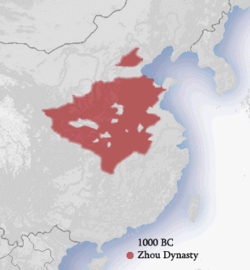King of Zhou
| Zhou | ||||||||||
| 周 | ||||||||||
|
||||||||||
|
Population concentration and boundaries of the Western Zhou dynasty (1050–771 BC) in China
|
||||||||||
| Capital | ||||||||||
| Languages | Old Chinese | |||||||||
| Religion | Chinese folk religion, Ancestor worship, Heaven worship | |||||||||
| Government | Monarchy | |||||||||
| King | ||||||||||
| • | c. 1046–1043 BC | King Wu | ||||||||
| • | 781–771 BC | King You | ||||||||
| • | 770–720 BC | King Ping | ||||||||
| • | 314–256 BC | King Nan | ||||||||
| History | ||||||||||
| • | Battle of Muye | c. 1046 BC | ||||||||
| • | Gonghe Regency | 841–828 BC | ||||||||
| • | Relocation to Wangcheng | 771 BC | ||||||||
| • | Deposition of King Nan by Qin | 256 BC | ||||||||
| • | Fall of the last Zhou holdouts | 249 BC | ||||||||
| Population | ||||||||||
| • | 273 BC est. | 30,000,000 | ||||||||
| • | 230 BC est. | 38,000,000 | ||||||||
| Currency | Mostly spade coins and knife coins | |||||||||
|
||||||||||
| Today part of |
|
|||||||||
| Zhou dynasty | |||||||||||||||||||||||||||||||||||
|
"Zhou" in ancient bronze script (top), seal script (middle), and regular (bottom) Chinese characters
|
|||||||||||||||||||||||||||||||||||
| Chinese | 周 | ||||||||||||||||||||||||||||||||||
|---|---|---|---|---|---|---|---|---|---|---|---|---|---|---|---|---|---|---|---|---|---|---|---|---|---|---|---|---|---|---|---|---|---|---|---|
|
|||||||||||||||||||||||||||||||||||
| Transcriptions | |
|---|---|
| Standard Mandarin | |
| Hanyu Pinyin | Zhōu |
| Gwoyeu Romatzyh | Jou |
| Wade–Giles | Chou1 |
| IPA | [ʈʂóu] |
| Wu | |
| Romanization | Tseu |
| Yue: Cantonese | |
| Yale Romanization | Jāu |
| IPA | [tsɐ́u] |
| Jyutping | Zau1 |
| Southern Min | |
| Hokkien POJ | Chiu |
| Tâi-lô | Tsiu |
| Old Chinese | |
| Baxter–Sagart (2014) | *tiw |
The Zhou dynasty (Chinese: 周朝; pinyin: Zhōu cháo [ʈʂóu ʈʂʰǎu]) was a Chinese dynasty that followed the Shang dynasty and preceded the Qin dynasty. The Zhou dynasty lasted longer than any other dynasty in Chinese history. The military control of China by the royal house, surnamed Ji (Chinese: 姬), lasted initially from 1046 until 771 BC for a period known as the Western Zhou and the political sphere of influence it created continued well into Eastern Zhou for another 500 years.
During the Zhou Dynasty, centralized power decreased throughout the Spring and Autumn Period until the Warring States Period in the last two centuries of the Zhou Dynasty. In this period, the Zhou court had little control over its constituent states that were at war with each other until the Qin state consolidated power and formed the Qin Dynasty in 221 BC. The Zhou Dynasty had formally collapsed only 35 years earlier, although the dynasty had had only nominal power at that point.
This period of Chinese history produced what many consider the zenith of Chinese bronze-ware making. The dynasty also spans the period in which the written script evolved into its almost-modern form with the use of an archaic clerical script that emerged during the late Warring States period.
...
Wikipedia

